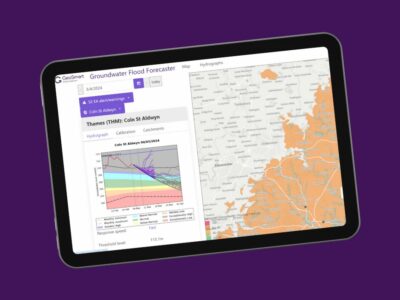SuDS on site: Responses to Site Conditions
Flood Risk and Site Profile
We examine the various site conditions that developers may face as they evaluate sites for the inclusion of SuDS through specific planning conditions.
We look at flood risk sites and additional constraints on slope profile. The following is a general guide taking information published by a number of Local Authorities including Kent, West Sussex and Hampshire as exemplar guidance.
Planning responses will be highly specific to the site, drainage and scheme requirements of each Local Authority, supported by their Lead Local Flood Authority.
SuDS on site and Flood Risk
Floodplains
Floodplains are there for a reason: to absorb and dissipate the impact of flooding by rivers or tides. They are natural features and are the best at doing the job, which is why development and hard features in flood zone 3b (the functional floodplain) are largely refused.
It should be noted that the Environment Agency flood zones for planning only consider main rivers. There may be active flood plains for smaller water courses which can be picked up from other sources, such as surface water flood risk maps.
Surface water runoff cannot be stored in locations that are likely to be inundated on a regular basis by the adjacent river. However, this doesn’t mean that SuDS aren’t allowed, as they can still cater for normal rainfall events when the river is not in flood.
Given the likely high groundwater table and vulnerability to erosion, SuDS on site should be designed in these areas in the following ways:
- Grading of slopes and the creation of surface features like berms or un-reinforced channels should be limited – these could easily be removed in a flood event, and may reduce flood plain storage capacity
- Surface water should be discharged in a broad flow, as opposed to a point or channel. SuDS systems should be designed to attenuate (slow and manage out) the surface water so that they are empty within 48 hours of an event, largely to avoid creating a wider flood risk.
- In many instances discharge to a surface water course may be a good option for site drainage. This will require knowledge of potential flood extent and levels relative to the site outfall to prevent back flow and ensure outflow can occur.
- Discharge to the surface water course is likely to involve construction in the flood plain. The final outfall design will need to be agreed with regulators and riparian owners.
Protecting the Site from Adjacent Flooding
You need to think holistically about the site, its setting and context in relation to neighbouring plots. It is quite possible that your site could be affected by next door which could be highly prone to surface run off.
You will need to consider how external overland flows impact into your site and design in features, such as swales, that intercept and divert this flow at the boundary. Otherwise the drainage system may not have sufficient capacity to deal with this extra water if the wider catchment wasn’t included in the design process.
All stakeholders need to be consulted with at the outset of the master planning process so that the runoff is managed as a collective solution, with the new development fully integrated with existing features.
Nearby Flood Risk Issues
If the site is in a Critical Drainage Area, or where there are other surface water flood issues, the Authority may impose further runoff restrictions. This in turn could impact on how you design or configure the layout for the SuDS solution.
Usually, the Authority will seek to ensure that the development and its supporting SuDS system mimic the action of the greenfield site that was there before. You will need to meet this standard so as not to exacerbate the problems down the catchment or slope profile. Again, these Greenfield standards vary by Authority so design has to be tailored to the profile, rather than one size fits all.
Our Flood Risk reports provide a detailed examination of general flood risk based on the site’s Flood Zones and in relation to national and local flood policy.
SuDS and Slope Profile
Flat sites
Managing surface water runoff on flat sites can be a challenge. A moderate slope is advantageous to move water around using gravity. If infiltration is possible then water can be dealt with close to source, making drainage easier. If a piped system is being used to convey surface water on a flat site, downstream SuDS can become deep and unattractive due to the drop required for pipe cover and gradient.
The best option on these sites is to keep surface water runoff on the surface as much as possible and to manage runoff close to its source. Water can be conveyed on the surface using roadside kerbs and shallow rills and swales.
A designer should consider all alternatives before considering pumping as a last resort.
Steep slopes
Steep gradients will increase runoff velocity. These sites require additional attention when accommodating SuDS. Infiltration is not recommended near very steep slopes, as it might reduce slope stability or lead to seepage further down slope.
Check dams and staged storage can be used to slow the runoff rates on steeper slopes. It is also important to consider how the gradient will impact on any buried storage features. For example, geo-crates or porous fill beneath permeable paving may also require the use of check dam features (stanks).
Another option is to design the site to convey runoff on platforms in a similar manner to switchback roads on mountainous terrain. Bio-retention and wetland features can be staggered in a terraced arrangement on slopes.
Getting an Accurate Site Appraisal
Our SuDS Reports provide the ideal start point for site drainage assessment. They offer an initial view on site drainage data including topography, sewer access, flood risk and infiltration capability for surface water drainage.
An assessment of discharge options is presented alongside more detailed run off calculations and preliminary SuDS design that can be used as part of the pre-planning engagement process with the relevant Local Planning Authority.
Contact us today on 01743 298100 or email us at enquiries@geosmartinfo.co.uk to discuss any projects you require assistance with.



